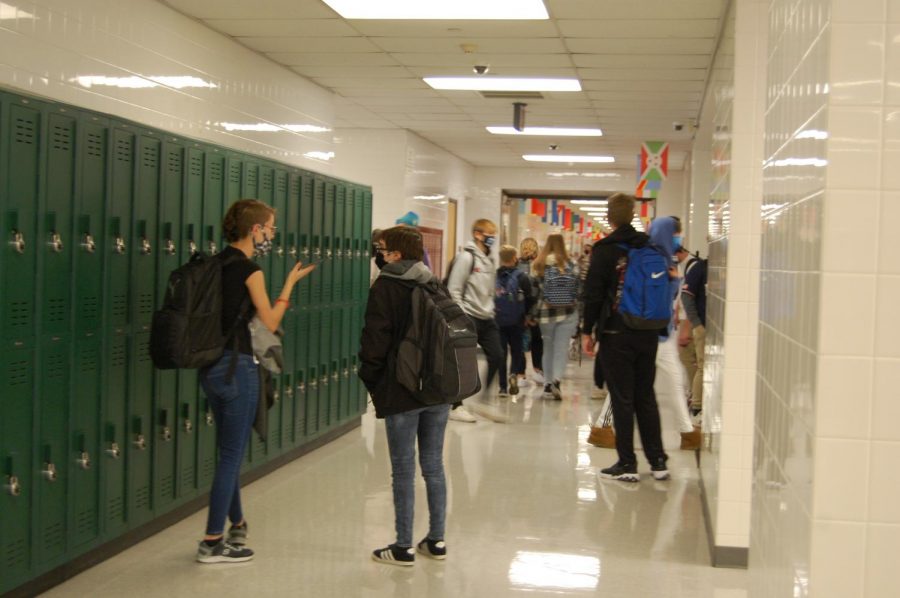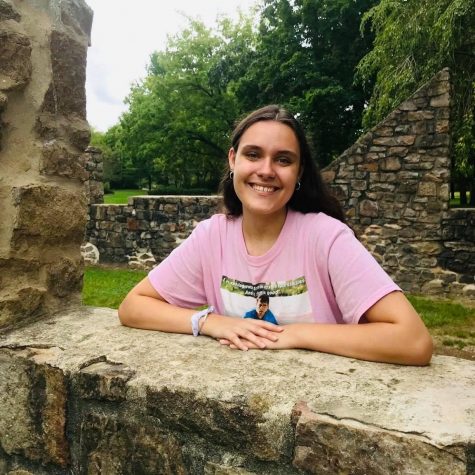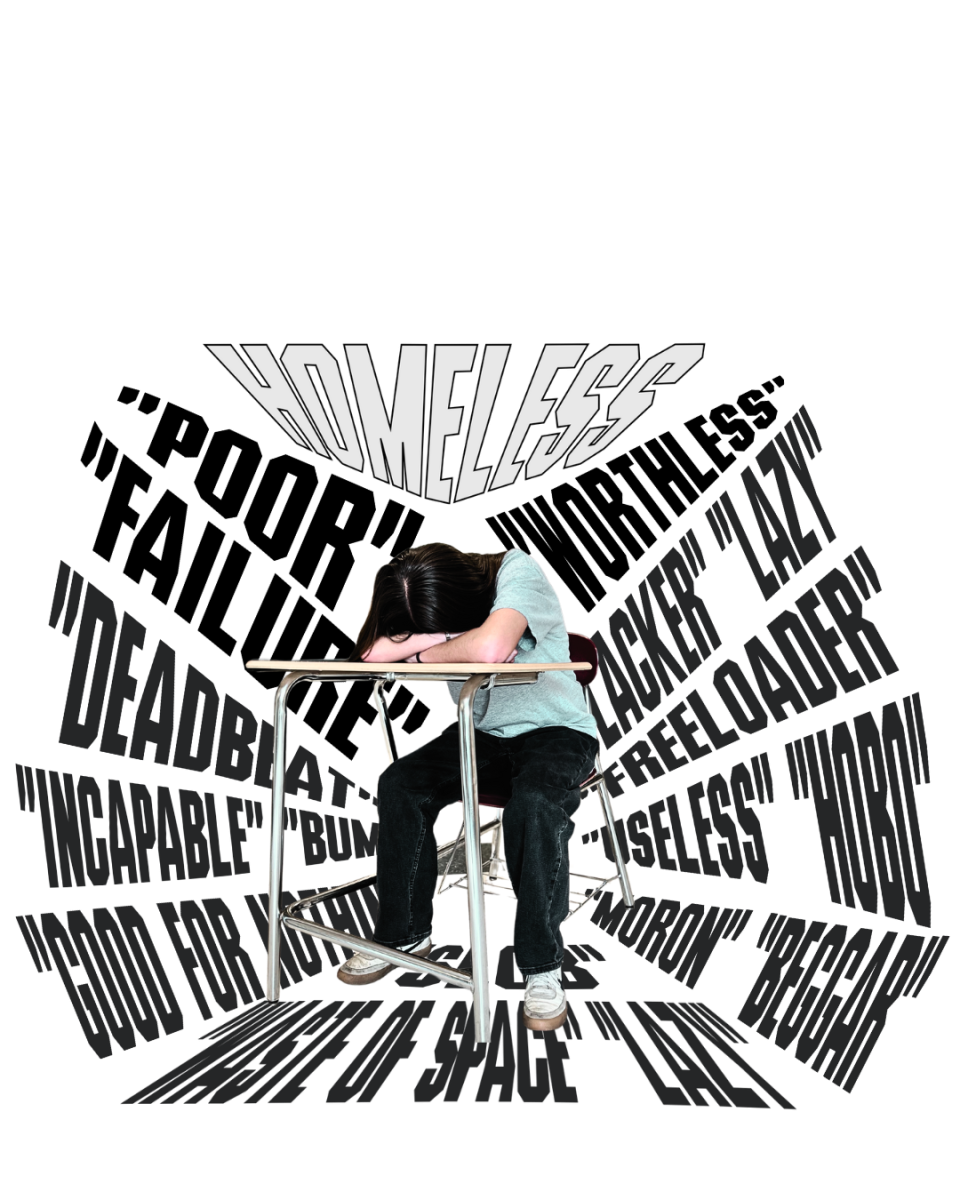Close to home: East Penn residents share experiences with COVID-19
As of Jan. 27, there have been 265 confirmed positive cases of COVID-19 within the East Penn School District. Photo by Meliha Anthony.
January 27, 2021
COVID — it’s a scary word, isn’t it?
There’s a specific connotation that comes to mind when one hears those dreaded words: “They have COVID.” Images of hospitals, overflowing with patients as doctors struggle with a shortage of essential materials; families separated by distance and fear; and the caution that now exists between strangers on the street. Many see COVID-19 as an experience entirely detached from themselves, a nightmare that couldn’t possibly apply to them. However, the East Penn School District suffers from COVID as much as any other district in the country. It has affected the lives of those who are close — teachers, students, staff — and they have experienced it, and all the subsequent emotions that come with it, firsthand.
When Emmaus High School senior Madison Friend learned that she had contracted COVID, she, of course, had some questions and fears.
“I was scared, honestly, because of just the stigma around it, you know?” Friend said of her immediate reaction. “I mean … there are all these different effects, like it affects everyone so differently. So, I was really nervous [as] to how I was gonna react or [how it would react] to my mom, because she’s high risk.”
Friend, who was participating in EHS’ hybrid model at the time, realized that she had COVID because of her family. According to the senior, her sister and father, who were not feeling well, took the test on Dec. 3. Their test results returned positive on Dec. 7.
Friend, as well as her brother and mother, decided to get tested as a precaution, but were unable to receive a formal diagnosis due to a shortage in tests.
“So [the doctors] just said, ‘Just quarantine, don’t go anywhere, and if you get sick, it’s going to be COVID,’” Friend said. “So … it was like a clinical diagnosis. The doctor said, ‘You definitely have COVID if you get sick, but we’re not going to actually test you because of the amount of tests we have available.’”
Not long after, she and the rest of her family began to show symptoms. According to Friend, her own symptoms were mild. So mild, in fact, that for a while they believed she might be asymptomatic. This assumption was proven false when she began to lose her sense of taste and started suffering an occasional fever.
Her family’s experience has “been up and down” so far, but Friend is grateful that it hasn’t been worse.
“It’s different for everyone,” Friend said. “My mom was really sick for a while. She had a fever, and she was just often not herself. And my brother was the same way. Same with my dad and my sister, but honestly, for me, it hasn’t been that bad.”
Jennifer Yard, a health room nurse at Macungie Elementary School, faced a similar experience in terms of symptoms.
Yard first contracted COVID back in April, when much was still unknown about signs of the virus and how to take precautions against it. After realizing one night that she was unable to smell the food she was cooking, Yard, who was working at her other job in a nursing home at the time, mentioned it to her coworkers. They informed her that it was a new symptom of COVID, and she left work to get tested. Within a day, it came back positive.
For about five days, loss of smell seemed to be the only symptom Yard had.
“I … got my smell back the next day, like on day six,” Yard said. “But on day six, I started having some chest pain, and a little bit of shortness of breath, and headaches. So, for the most part, I just felt like I had to sit down. I was too exhausted. I’d get up to do something, and I just felt really exhausted, and my head was hurting a lot.”
For the duration of her quarantine, Yard would regularly monitor her pulse oximeter, a device that measures her oxygen saturation. When she would exert herself, it would drop into the 70s, when it should have been in the 90s. Her pulse ox would go back up as soon as she sat down and relaxed.
Despite her continual surveyance, Yard was still concerned about her high-risk status, the danger it posed to her family, and the experiences she had with the virus in the past.
“I did get a little concerned because I have asthma, and was starting to get a little bit anxious about, ‘What does it have in store for me,’ you know?” Yard said. “[There were] a lot of people at the nursing home I was taking care of [with COVID], and they died. So, that was the point where I started to get a little bit anxious and just tried to, you know, keep everything calm for the family.”
Although she experienced symptoms for just 14 days, with only sporadic headaches afterward, Yard had to alter her everyday life and the way she acted within her own home to a greater extent. She would make sure to take her shoes off and not wear them in the house. She was “very careful” with her laundry and would take a shower no matter what time she got home, even if it was the middle of the night. For the first few days, when they were uncertain of the test results, she would wear a mask when walking around the house.
Her extended quarantine period due to her job with the school district only exacerbated these changes. Even when she could have returned to work, Yard chose to continue to quarantine to not put any of the Macungie students or staff in danger.
“Because at that point we didn’t know if you would have immunity,” Yard said of her decision to remain at home. “Like, could you get it again right away or would you have immunity for a short period of time? So nobody was really sure. So, you know, that was a little bit isolating, if you will, because I really had to put myself on quarantine for a longer time than usual just so that I could be able to be there and get the students’ meds and things set up for the summertime.”
As someone who experienced COVID firsthand, Yard believes that the district’s focus in keeping their students safe is equal to her own when she made that choice.
“I feel really good about the way East Penn is handling COVID in the school,” Yard said. “I think that we’ve done a really good job of providing a safe environment for the students. It’s not ideal, the students don’t love being so far apart [in] the cafeteria, you know, for the upper grades. But I think that they’ve been doing a good job out of making the school a safe place to be.”
Friend also believes that EHS, specifically, ensured they were being careful when bringing students back in for hybrid, and she hopes that they continue to be just as cautious in the future.
“I’m glad they didn’t put us in right away because, you know, we didn’t have any nurses or anything like that,” Friend said. “So I’m glad we got that sorted out then. But I mean, you know, we just went right back anyway, so I feel like we just need to stay remote until everything gets more controlled.”
Nicole Kujas, a senior at EHS who suffered from the virus during holiday break, feels that the district and the school board have done a commendable job letting residents know whether or not students would be returning.
However, Kujas does wish that there were more certainty to the current situation.
“I think for the most part, it’s been handled pretty well,” Kujas said. “I think maybe just a little more communication just in like, some sort of thing — ‘cause sometimes we never know if we’re going to be going back to hybrid or if we’re gonna be extended back into remote, so just some more, I guess, communication with that.”
Kujas’ parents tested positive for COVID the week before holiday break. To be safe, Kujas also took the test, and it returned positive on Dec. 28. Much like Friend, her symptoms were mild. She experienced a stuffy nose and, for about two days, a slight loss of sense of smell. Due to her initial lack of symptoms, she was unaware she was sick for almost five days.
After realizing she had the virus, one of Kujas’ concerns involved the stigma surrounding COVID. She “didn’t want to tell anybody” that she had contracted it out of fear that they would think she was being unsafe, despite her taking similar precautions to Yard.
“I definitely felt that kind of stigma, almost like slightly embarrassed,” Kujas said. “I was like, ‘Oh, I got COVID, am I doing something wrong?’ But the virus is so easily transmitted and sometimes you don’t even know you had it … like, I didn’t know I had it. So again, it’s hard to kind of balance all those thoughts that run through your head. But if you had it [then] you had it, like, you can’t change that now.”
Friend, too, felt that stigma around COVID, but does mention the recent lack of concern regarding the virus.
“I remember in March and April and all that … it wasn’t as nearly as bad, but we were all cleaning our groceries,” Friend said. “We were terrified and just not going out because we were on a lockdown, and it was just so scary. But, I mean, now it’s like 10 times worse, but we’re not doing anything about it — not that we’re not doing anything, but I mean we’re not as concerned for it. And I just feel like the stigma, it’s kind of gone down a little bit as time has passed because everyone’s like, ‘Oh, I just want to get it over with. I just want this to be done.’ But yeah, I mean, it’s still such a real thing.”
As someone who has experienced COVID, Friend encourages others to ensure they remain safe moving forward.
“I never thought I would get it,” Friend said. “I was like, ‘Oh yeah, people get it, but I’m not gonna get it.’ It’s just so unexpected, and when you do get it, it’s kind of a reality shock, like, ‘Shoot, this is a real thing.’ So, I guess, to other people, just keep social distancing. Just keep doing what you’re doing because it’s so unexpected and, you know, thank God it didn’t hurt my family at all. We’re all fine now but [with] other people, that’s not the case.”
Kujas suggests the same safety measures, as well as remembering to maintain an optimistic outlook on the situation.
“You have to try to keep that positive mindset [that] even though you have it and you have to quarantine, or you’re worried about something, eventually it’s gonna be over,” Kujas said. “Eventually we’ll be able to kind of, I guess, return to some sort of normal lifestyle. So, I would just say to keep a positive mindset and, if you can, safely talk to the people you love around you, just to kind of remind yourself that you still have them in your life.”
With the CDC’s current authorization of two COVID-19 vaccines — the Pfizer-BioNTech vaccine and Moderna’s vaccine — that return to normalcy may come sooner than expected. Along with these developments, however, comes uncertainties and questions about the safety of the vaccines.
Yard encourages those who have doubts to research the vaccines, stating that she, too, still has “a lot of questions,” especially regarding its effects on those who have already had COVID.
“I think that any vaccine that they put out should be approached with the same caution that you would do anything,” Yard said. “Of course, they don’t have long term studies out, but I don’t think they would put out a vaccine knowing that it was not safe. So, I would not deter anybody from getting the vaccine. As to whether I would get it myself or not, I don’t know.”
Kujas applauds the medical professionals who have been working “so tirelessly” to find a proper way to vaccinate the public. Her own personal experience with her grandmother living in an assisted living home has only strengthened this appreciation.
“I know for me, my grandmother has some memory issues,” Kujas said. “So the being stuck inside and not being able to see her children has really affected her memory. I think the vaccine would be a good way for us to maybe return to … a sense of normal without, obviously, endangering our loved ones, because we never want to put them in danger, like that’s never our intention. So, I think, maybe, [the vaccine] would help provide a little bit of a safer place for everybody.”
How the situation will continue to evolve is, as Friend astutely described, “uncertain.” However, she, along with Yard and Kujas, emphasize the importance of not letting the stress of life become too overwhelming and maintaining hope for the future.











